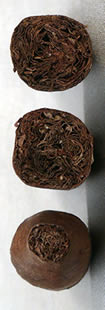Petit Corona Selection
Your opportunity to try one of the more popular sizes – very flexible, perfect for an in-between smoke since it would normally last about 40–50 minutes. This is the size of the Montecristo 4 – the biggest-selling single cigar from Cuba.
These three (all highly rated by Cigar Aficionado) are all from Cuba, but they are not all the same – different plantations, leaves from different parts of the plants, different curing, different methods of construction - the blending of each of these brands leads to differing strengths of flavour. Two classic corona (Parejo) shapes (mild to medium strength and flavour), and the uncommon Perfecto (double figurado) - designed to be rich and full-bodied.
What do you think?
Colin Wesley
Rafael Gonzalez Petit Corona (Mild-bodied)
A totally handmade cigar manufactured from a secret, light-tasting, blend of Vuelta Abajo tobaccos selected by the Marquez Rafael Gonzalez (Grandee of Spain). Each box carries a curious inscription written in English to the effect that the cigars should be smoked within one month of the date of shipment from Havana or otherwise they should be carefully matured for about one year. We’re in luck – these were boxed in May 2008. This is reputed to be a smooth, mild bodied Havana cigar with a sweetness “highlighted by a flavour profile of vanilla, wood and leather notes”.
Partagas Mille Fleurs (Medium) - Second oldest Cuban brand, the Partagas brand is named for its founder, Don Jaime Partagas, who in 1845, opened up the famous factory at 520 Industria Street in Havana, Cuba. The Mille Fleurs is machine bunched, hand finished. The La Corona factory produces many of these machined cigars under the strict supervision of the Partagas factory, which supplies the raw materials thus ensuring quality and consistency. Good Cuban flavour, excellent value from this more affordable Cuban cigar.
Cuaba Generosos (Perfecto, 132mm x Ring 42)
Cuaba is the only all Perfecto Cuban range –launched in 1996. The Perfecto is the original shape that made Cuba famous but the shape hadn't been commercially rolled for nearly 100 years. The name comes from the bush, pieces of which were used by the early Indians of Cuba to light their cigars (cohibas). The first thing you notice about Cuabas is their varied shapes. They are all standard lengths, but all slightly different in shape. This is because the cigars are made without the aid of a mould, which standardizes the girth and shape of a cigar. They are made in the Briones Montoto factory (formerly Romeo y Julieta), by only Grade 7 rollers – the highest rated.
The Perfecto (or double figurado) is the hardest shape to make in Cuba. "You have to have great strength and skill in your hands and you have to know where to put the right amount of pressure on the filler and binder” says Gonzalez, who developed the range and has been working at Briones Montoto since 1948. "I wanted the cigar to be strong at the beginning when you smoke it and then end with a smooth richness”.
Strangely, the cigar has no ligero tobacco, the strongest of the three tobaccos used in Cuban cigars, even though it delivers such intensity on the palate.
|


